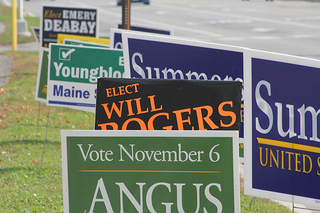 Maine Public Radio’s Jennifer Mitchell interviews Jon Ippolito about the proliferation of colors in advertisements for this season’s political candidates, and what subliminal messages these new palettes might contain.
Maine Public Radio’s Jennifer Mitchell interviews Jon Ippolito about the proliferation of colors in advertisements for this season’s political candidates, and what subliminal messages these new palettes might contain.
While the garish colors of political signs dotting U.S. roadsides this month may be an eyesore from an aesthetic standpoint, from a political standpoint they signal the emergence of a broader spectrum beyond the tired red state / blue state divide of Republicans and Democrats.
Maine Political Signs Carry Subliminal Messages
Every year about this time, you start noticing the little forests of political signs popping up on every greenbelt in the neighborhood. The reason is that there’s a candidate who would like your vote. And according to those who scrutinize politics and media, there’s also an unspoken message in the signs’ color and design….You may notice this season that a growing number of political sign designs out there stray beyond the classic American palette of red, white, and blue.
“I think in some cases they represent the presence of deliberate third parties,” says Jon Ippolito, a media and design specialist with the University of Maine. He says that it’s increasingly common to see lawn signs clad in purple, orange, and yellow. And green especially, he says, seems to be gaining traction as a symbolic campaign color.
“Green being a symbol both of environmental consciousness, growth also, and money, in the sense of economic boon,” Ippolito says. “So we associate green with a company like Starbucks that represents both the economic and the kind of ecological, you know, Seattle vibe….”
Orange on a sign, says Jon Ippolito at the University of Maine, may imply industry and energy – reminiscent of road crews or a big business like Home Depot, which also uses an orange color scheme. The color is also a hard one to ignore….
They work rather like advertising jingles, says Jon Ippolito at the University of Maine. Studies have shown that the more annoying the jingle, the more people remember it. Both Daniel Shea at Colby College and Ippolito agree that there are many ingredients that go into a successful political sign recipe – it’s just not clear which ingredients resonate with with voters, and exactly how many signs do the trick.
Here’s the audio stream:
